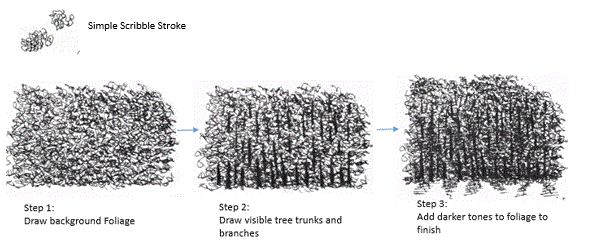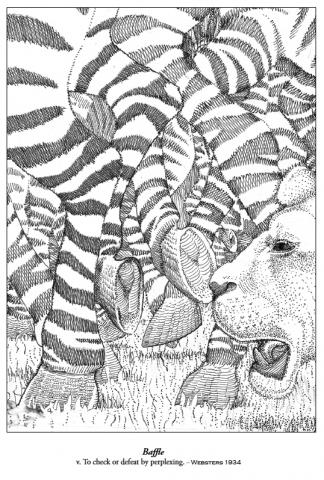Search the Community
Showing results for tags 'pen and ink'.
-
Bark texture is ideally suited for drawing with pen and ink and one of really fun drawings in this regards is drawing an old tree stump with deep crevices and grooved bark. Here I will show how with simple stroke and technique you can draw one. There are limitless variations on this and one can be drawn from imagination anytime. Step 1: Draw the Outline. Notice the irregular edges used to draw the outline. Step 2: Draw Main CrevicesMain aspect of an old stump are deep grooves and crevices in it's body with age. Draw them as shown below with bigger towards the centre and smaller towards the edge. Use the irregular outline and taper them. Also add them irregularly to avoid any pattern. Step 3: Darken CrevicesDarken the crevices using parallel lines or you can even use a brush. Step 4: Add Bark StrokeAdd bark stroke to bring out the feel of bark on the stump. Bark stroke is discussed in detail in drawing tree trunk tutorial. Step 5: Add Small Tapered Crevices and Edge IrregularitiesAdd small tapered crevices by darkening the bark lines as shown below. Make it irregular. This starts to bring out the feel of rough bark texture on the stump. Step 6: Darken One Side MoreDarken one side more to bring out the feel of roundness for the stump. Light doesn't fall uniformly on a curved surface and such tonal differences are needed to bring out the form of a curved object. This is discussed in detail in vol 1-2 of my pen and ink drawing workbooks. Rough bark texture with deep grooves and rounded feel of stump is now established. Step 7: Texture RootsUse curved parallel lines as shown below to give a curved form to the roots. Step 8: FinishFinish by adding small tapered crevices and darkening one side of roots to bring out their form as well. This completes this drawing. As you can see above the technique and stroke used are very simple and and by using different shape of outline and size and placement of crevices different variations on this can be easily drawn from your imagination. Following is another example. In yet another variation, holes in the stump can be indicated to indicate further decay. Following are 2 additional examples. In the following examples, grass is added to ground the stump as well. This completes this post. Hopefully you found it useful and motivated you to try doing such pen and ink drawings. If so, you can further check out my FREE pen and ink drawing tutorials and pen and ink drawing workbooks to learn to draw pen and ink landscapes in step by step illustrated manner. Happy Drawing, Rahul Subscribe Older Step by Step Drawing Posts
-
https://youtu.be/j8L10tZhxOo
- 1 reply
-
- drawing
- pen and ink
-
(and 1 more)
Tagged with:
-
Here is a very simple way to draw a wooded area using simple scribble stroke. Watch the video demonstration and follow along. This simple fun drawing can be done anywhere and is always enjoyable. If you like the experience and want to adopt drawing simple landscapes with pen and ink as a creative and relaxing hobby, then check out completely free tutorials I have created for this purpose. Have fun, Rahul www.pendrawings.me
-

Long Time Pen And Ink Artist Recently Converted To Fountain Pens
Nigh Means Near posted a topic in Introductions
Hi everyone! I've been lurking for a while now and thought that I should make an account and introduce myself. My name is Bill; I'm a long time pen and ink artist, but only recently made the transition from dip to fountain pen. Certainly one of the best choices I ever made. I'm also a university student working in a visual cognitive neuroscience lab, which involves a lot of writing. Fountain pens have really enriched that aspect of my life as well. One thing I've noticed in the few months that I've been acquiring fountain pens, (and I've acquired a fairly distressing number in that time), is that the pens that are the best for writing are rarely the best for drawing and vice versa. I've been watching many pen reviews on line, (my favourites being from Brian Goulet and sbrebrown [who, as my lovely wife has just informed me posts here]). One thing I've noticed is that most of the reviews I've seen focus on writing with fountain pens, but very few focus on drawing. It's my plan, over the coming months, to film some reviews of my favourite pens from the artists perspective. In case anyone is interested, I thought that I'd post some examples of my work. I've been super impressed with the quality of the posts I've read here. I've learned a lot already, and hopefully I can provide a valuable perspective. Thanks for reading.- 18 replies
-
- drawing
- pen and ink
-
(and 1 more)
Tagged with:
-
I post my Waterman Phileas pen and ink drawings at www.twelvedrawings.com Some background: I create drawings based on words associated with Twelve Step recovery. I use definitions found in a 1934 Webster's dictionary because some subtle changes have occurred since the AA Big Book was published in 1939. Pen and ink drawing have been a staple of popular art for centuries. I hope the artform will always endure—despite the advent of new computer software. There is a rather timeless quality about pen and ink drawings that can blur the lines between historical periods. That timelessness is an effect I deliberately try to achieve. Why? Becauase if I had one wish, it would be to help the younger reader look beyond the antique-sounding vocabulary found in recovery literature like the Big Book. Within that "grandfatherly" writing can be found very specific, definite, and practical instructions for those who wish to be freed from alcholic and addictive insanity. These illustrations are how I carry that message. I use 9 x 12" paper and a medium Waterman fountain pen—like the one seen in the drawing called "Difference"*. You will probably notice pencil sketch marks here and there on the drawings. I try to erase them because they are distracting to some people. To be honest, I draw mostly for my Higher Power and thankfully He has the job of being perfect, not me.
- 48 replies
-
- twelvedrawings
- waterman
- (and 6 more)
-
Sasha Royale, Hmm. What an interesting question—one I can answer only for my own experience creating www.TwelveDrawings.com Fountain pens are much more closely associated with writing than with drawing. In fact, I don't personally know any artists who use a fountain pen. I am pleased to find artists here on the Fountain Pen Network, but I think fountain pen usage is probably rare in the general population of artists. WHY NOT USE PENCIL? First, I should explain why I prefer using pen and ink vs a pencil. I can and do use pencil for sketching but have always preferred the demands and rewards of pen and ink. I would compare pencil use with skydiving, where there is real excitement involved but also ample room for correcting minor errors. Pen and ink is more like B.A.S.E. jumping which is very unforgiving of even the smallest mistake. (Not that I am brave enough to actually try either dangerous sport for real). Every mark or motion made by a pen will remain visible in the final drawing, so there is a bit of risktaking in each new stroke of a pen. WHY NOT USE A CALIGRAPHY PEN? This one you already know. The chisel-shaped nib required to make those wonderful letter forms is not well-suited for my style of illustration. WHY NOT USE A TECHNICAL PEN? Most pen and ink artists I know are fond of Rapidograph technical pens https://d2npbuaakacvlz.cloudfront.net/images/uploaded/large-present/2012/7/13/rapidograph-pens-1342201371.jpg These unique pens were used worldwide for creating architectural blueprints and engineering drawing. They come in an astonishing array of nib widths, but are must be held almost perpendicular to the page, rather than in an oblique handwriting position. Although I love Rapidographs, I prefer a pen that lets me use a relaxed handwriting grip.....thus, I use a Phileas. WHY NOT A MORE EXPENSIVE FOUNTAIN PEN THAN PHILEAS? Here I must declare a tiny bit of Divine intervention. I had only a brief interest in fountain pen as a child. Then, in middle age, I came across a display of Phileas pens in the Staples office supply store. I was mostly an idle doodler at that time, so I'm not sure why I suddenly wanted to own the Phileas. Its $50 price tag seemed absurdly high since my favorite drawing pen at the time was a $1.49 Pilot RazorPoint felt-tip pen. I took the plunge and bought what for me was an exorbidant luxury item. (Only much, much later did I learn that the Phileas is viewed by connoisseurs as a low-end "economy model" pen.) I was mesmerized by the very things that Waterman had purposely included...nostalgic Art Deco styling, glossy black enamel, and gleaming gold details. I don't usually collect "bling", but I liked owning this one particular bit of dazzle. WHY NOT A LESS EXPENSIVE PEN? I have formed a loyal bond with the Phileas. My devotion is not entirely rational, but it harms no one that I don't seek out less-expensive alternatives. WHAT'S TO LIKE ABOUT THE PHILEAS? • FEEL: Looks aside, I found the Phileas to have an excellent "feel" when writing or drawing. Other than my one childhood pen (a Sheaffer?), I have no basis for comparison. Today, I realize I was not alone in admiring the smooth performance of Phileas. The high-end Waterman designers seem to done a remarkable job when they created this low-end pen. It writes cleanly, delivers ink reliably, is physically rugged (when the cap is firmly on), and very easy to maintain. • CONSISTENCY: Like most ink illustrators, I primarily use dots (stippling) and lines (hatching) in my illustrations. A typical fountain pen is meant to create handwriting, but there are plenty of dots and lines in that. However, when I am drawing, I work very very fast. My Phileas must deliver up to 200+ dots per minute—that's averages 12,000 strokes per hour. Multiply that by 2 to 8 hours per drawing, times 70+ drawings and you'll see I am putting my Phileas through torture-test conditions. I have never "worn out" a Phileas pen. I have lost one and ruined two (accidentally dropping them nose-down onto concrete), but they work as well when old as they did new. • DIVERSITY: The afore-mentioned Rapidograph technical pens deliver a consistent, near-perfect round ink dot with each tap. That's why so many artists love them. When I draw, I am improvising constantly and do not want to see a perfect uniformity in my pen marks. The Phileas is capable of drawing very neatly, but it can also deliver scratchy, sloppy, and even wild lines given the right drawing technique. When I examine my stippling under a mangnifier, I am amazed that no two dots look alike. That would drive perfectionists crazy, perhaps, but I like it in a jazzy improvisational sort of way. Thank you for asking a very interesting question, Sasha Royale. I had never given any of the above much thought before. I know there are many much-finer pens in the world. But by Divine intervention or just plain luck, I found the right one for me (and my budget) on the first try. Since I am a pen user, not a collector, I am contented to stop with what I've got. I am curious how other fountain pen artists would answer your question. TweveDrawings
- 5 replies
-
- phileas
- fountain pen
- (and 8 more)
-
Goodmorning! I would like to share recent YouTube videos of an artwork using a Montblanc 149 with a nib grind by Michael Masuyama. The needle-like tip is just perfect for the type of detail work that I enjoy. The ink used for this artwork was Cafe Des Iles by J. Herbin. The paper is an 11 inches by 17 inches Strathmore 2-ply Smooth Bristol board. The pencil used for the initial sketch was a Blackwing pencil by Palomino Brands. At the last stage of the process--from mid to end portion of Video Part 4--the MB 149 pen was turned into a quick airbrush/atomizer tool using a simple soda straw to create fine mist sprays for soft shading and blending, as well as coarse spatter ink sprays for texture work. Video Part 1 of 4 - [Note: When I began this recording, I didn't think I would upload it publicly on YouTube. As such, this first part was recorded at a local restaurant and my friends at the table convinced me to share the entire process. The other three videos were recorded privately in my art studio]: Video Part 2 of 4: Video Part 3 of 4: Video Part 4 of 4: Below are links to the video. Part 1 - Part 2 - Part 3 - Part 4 - Thank you letting me share this post with you... and best regards, Ced
- 10 replies
-
- montblanc
- meisterstuck
-
(and 6 more)
Tagged with:














